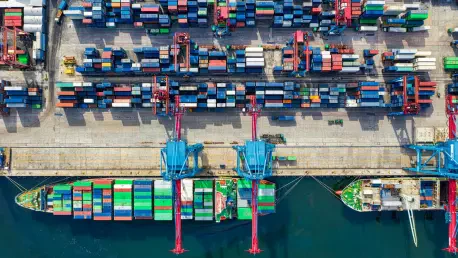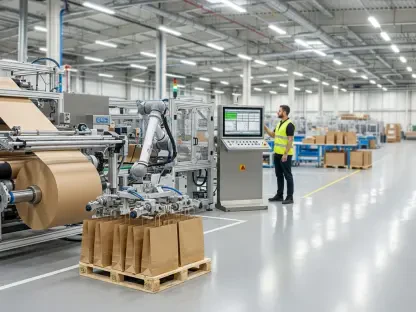Africa stands at a critical juncture in its economic journey, blessed with immense resources and potential yet shackled by fragmented supply chains that hamper progress across vital sectors such as mining, agriculture, and manufacturing. The continent frequently depends on imported components and materials, a dependency that inflates costs and erodes its ability to compete on the global stage. Meanwhile, China, commanding nearly 30% of the world’s manufacturing output, emerges as a potential partner to bridge these gaps with its vast industrial capacity. This article delves into the possibility of leveraging China’s strengths to address Africa’s persistent supply chain challenges, examining whether such collaboration can pave the way for sustainable growth. Beyond merely increasing trade figures, which neared $300 billion in 2024, the focus is shifting toward deeper, quality-driven partnerships. With geopolitical tensions and global economic shifts adding complexity, the urgency to rethink traditional approaches has never been greater. This exploration will assess the complementary dynamics between the two regions, the role of infrastructure, targeted solutions for supply chain woes, and the broader trends shaping this evolving relationship.
A Synergistic Economic Bond
The foundation of China-Africa collaboration rests on a striking economic complementarity that could hold the key to resolving longstanding supply chain inefficiencies. China’s exports, dominated by machinery and consumer goods, align closely with Africa’s pressing needs for infrastructure development and market demands. In return, Africa supplies critical raw materials like petroleum and copper, fueling China’s industrial engine. This mutual dependence creates a unique opportunity to move beyond transactional trade into a more integrated partnership. Experts suggest that by embedding Chinese industrial know-how into African markets, both regions can address structural weaknesses that have historically hindered growth. The synergy is evident, but the challenge lies in translating this potential into actionable strategies that benefit local economies.
Another dimension of this partnership is the stark contrast in industrial capacity and the chance it offers for Africa to bypass traditional developmental hurdles. With manufacturing in Sub-Saharan Africa constituting just 10.65% of GDP in 2024—a significant decline over decades—there’s a clear need for revitalization. China’s expertise in production and technology transfer could serve as a catalyst to rebuild this sector, fostering not just output but also skills and innovation. However, success depends on tailoring these interventions to Africa’s specific contexts, ensuring that investments don’t merely replicate foreign models but adapt to local realities and priorities. The path forward requires a delicate balance of ambition and practicality to create lasting impact.
Building Blocks of Connectivity
China’s extensive involvement in African infrastructure development has already begun reshaping the continent’s economic landscape, providing a critical foundation for addressing supply chain fragmentation. Projects spanning railways, highways, ports, and industrial parks enhance connectivity between markets and resources, enabling smoother flow of goods and services. These initiatives draw inspiration from China’s own rapid development, blending commercial viability with public benefits to create sustainable outcomes. The impact is tangible—improved transport networks reduce logistical bottlenecks that have long plagued African trade. Yet, while these advancements are promising, they represent only the first step in a broader industrial transformation that must tackle deeper systemic issues.
Infrastructure, though vital, cannot single-handedly mend the broken links in Africa’s supply chains, where even basic inputs like packaging often come from abroad at exorbitant costs. Chinese-backed industrial zones and manufacturing clusters offer a potential solution by promoting localized production, which could cut dependency on imports and lower expenses. However, their effectiveness hinges on alignment with Africa’s unique economic conditions and regional integration goals. Without careful planning, such projects risk becoming isolated enclaves rather than engines of widespread growth. The focus must extend beyond physical structures to encompass policies and partnerships that ensure these investments yield inclusive benefits across diverse communities.
Tackling the Core of Fragmentation
At the heart of Africa’s economic struggles lies the persistent issue of fragmented supply chains, a barrier that inflates costs and diminishes global competitiveness in key industries. Whether it’s mineral processing or agricultural exports, the absence of cohesive upstream and downstream linkages forces reliance on external markets for essential components. This not only delays production but also erodes profit margins, making African goods less viable internationally. China’s industrial ecosystem, renowned for its comprehensive full-chain capacity, presents a model for building these missing connections. By establishing localized manufacturing hubs, it’s possible to streamline processes, reduce expenses, and enhance the value of African products on a broader scale.
The potential for transformation becomes clearer when considering specific sectors ripe for integration, such as mining and agriculture, where supply chain gaps are most pronounced. Chinese investments could facilitate end-to-end systems—from resource extraction to processing and packaging—creating self-reliant economic cycles. Such an approach would not only bolster efficiency but also generate employment and foster skills development within local populations. Nevertheless, implementation must prioritize sustainability and equity to avoid exploitation or uneven gains. Strategic collaboration, supported by clear policies and mutual accountability, will be essential to ensure that these efforts address fragmentation without introducing new dependencies or disparities.
Adapting to Local Needs and Priorities
A notable shift in China-Africa economic ties is the growing focus on domestic and regional markets, reflecting a maturation of investment strategies to meet Africa’s specific demands. Chinese firms are increasingly targeting sectors like food processing, building materials, and fast fashion, where high import costs create opportunities for local production. This pivot from export-oriented ventures to addressing immediate consumer needs signals a deeper understanding of market dynamics. Agro-industrial parks and enterprise clusters are becoming central to this strategy, serving as hubs that link various stages of production and distribution. Emphasizing quality over sheer volume in these projects marks a significant evolution in bilateral cooperation.
This localized approach also underscores the importance of creating self-sustaining economic systems that can withstand external shocks. By fostering industries that cater to African consumers, Chinese investments help build resilience against global market fluctuations and trade barriers. These efforts, when paired with capacity-building initiatives, empower local businesses to thrive independently over time. However, challenges remain in scaling these models across diverse regions with varying needs and infrastructures. Careful coordination between governments, private sectors, and communities will be crucial to ensure that such investments don’t just fill immediate gaps but contribute to a broader framework of economic stability and growth.
Resilience Amid Global Pressures
Despite mounting external challenges, including trade barriers in Western markets and shifting geopolitical landscapes, China-Africa cooperation demonstrates remarkable resilience through established frameworks. Platforms like the Forum on China-Africa Cooperation (FOCAC) and the Belt and Road Initiative (BRI) provide structured avenues for dialogue and joint action, enabling both regions to navigate uncertainties with confidence. These mechanisms have proven effective in maintaining momentum, even as global economic conditions tighten. The focus now is on leveraging these partnerships to prioritize strategic sectors such as mining, agriculture, and light industry, where mutual benefits are most achievable and supply chain integration can yield significant results.
Looking at the broader picture, this collaboration offers a counterbalance to global protectionism by emphasizing regional integration and self-reliance. As Western markets impose restrictions, the emphasis on domestic African markets and intra-regional trade becomes a pragmatic response. Chinese capacity can support this shift by enhancing production capabilities and logistics networks that connect African nations more effectively. Yet, sustained success will require ongoing adaptation to evolving political and economic realities. Both regions must remain agile, refining their strategies to address emerging risks while capitalizing on opportunities for deeper industrial and economic alignment in the years ahead.
Charting a Sustainable Path Forward
Reflecting on the journey of China-Africa collaboration, it’s evident that significant strides have been made in laying the groundwork for economic transformation through infrastructure and trade. The partnership has tackled initial barriers by enhancing connectivity and boosting industrial potential across the continent. Supply chain fragmentation, once a formidable obstacle, has seen incremental improvements as localized production gained traction in key sectors. The resilience shown in navigating global challenges underscores the strength of established cooperative frameworks that adapt to shifting dynamics with a focus on mutual benefit.
Moving into the future, the emphasis should center on scaling these efforts with precision, ensuring that investments in industrial capacity and supply chain integration prioritize long-term sustainability. Stakeholders must explore innovative financing models and technology transfers to empower African nations beyond immediate gains. Strengthening regional policies to support agro-industrial hubs and manufacturing clusters will be vital in creating robust economic ecosystems. By focusing on these actionable steps, the collaboration can unlock untapped potential, setting a precedent for how strategic partnerships can address deep-rooted challenges and drive inclusive growth across diverse landscapes.









